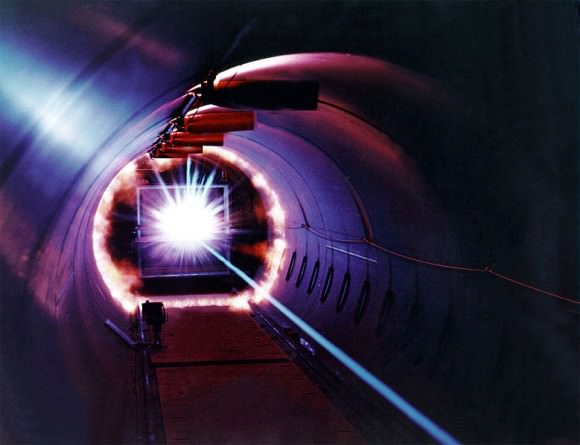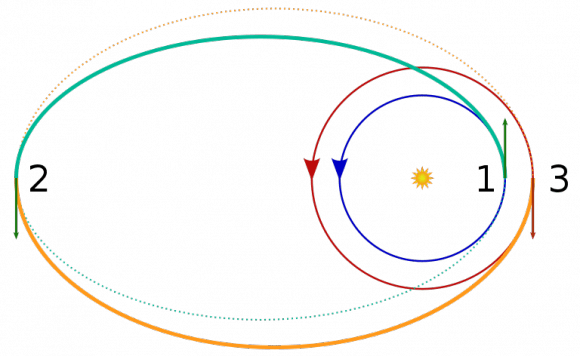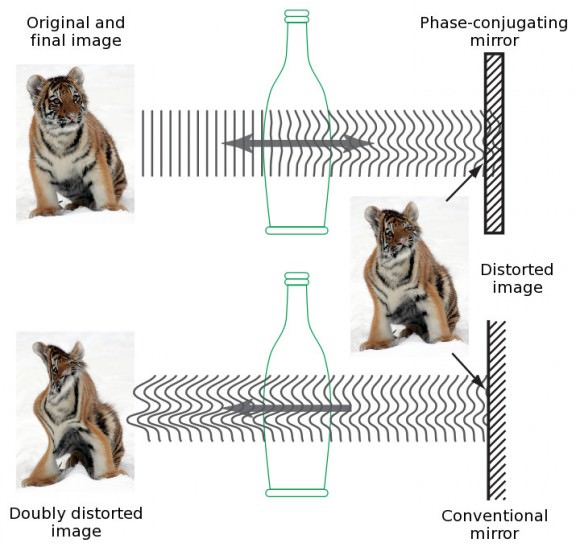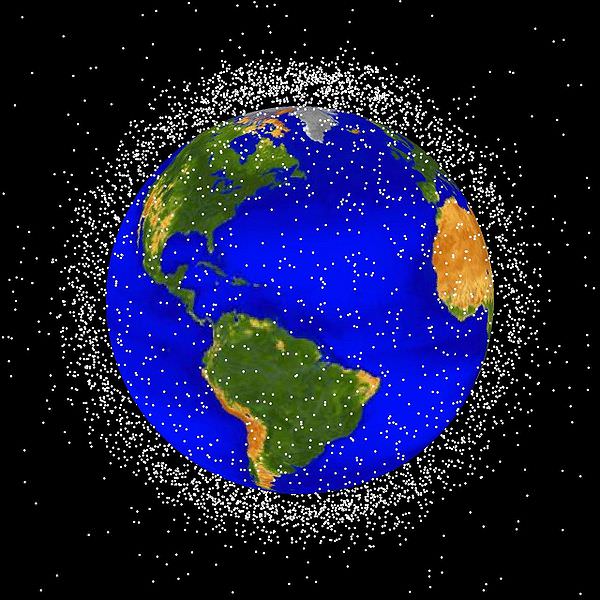[/caption]
This scenario isn’t science fiction. In June of 2011, Universe Today reported that “six crew members on board the International Space Station were told to take shelter in…two Russian Soyuz spacecraft.” As more satellites reach the end of their operational lives, there will be more space junk emergencies in space and on the ground, undoubtedly with less pleasant results. Our young space faring society has been lucky so far: the ISS has been able to steer clear of space junk, and falling, uncontrolled satellites have thankfully fallen into the oceans. But one day our luck will run out.
There is hope, however. A new paper titled Removing Orbital Debris with Lasers published on arXiv proposes using a high-power pulsed laser system from Earth to create plasma jets on pieces of space debris, slowing them slightly, causing them to re-enter and burn up in the atmosphere or fall into the ocean.
Claude Phipps and his team from a high-tech company named Photonic Associates outlined their method, called Laser Orbital Debris Removal (LODR) which uses 15-year-old laser technology which is now readily available.
The team recognized that “thirty five years of poor housekeeping in space have created several hundred thousand pieces of space debris larger than one cm in the …low Earth orbit (LEO) band.” These may not seem like large objects, but with the energy density of dynamite, even a large paint chip can cause major damage.

Removing debris is an urgent task because the amount of debris currently in space poses “runaway collisional cascading,” with objects colliding with each other, creating even more pieces of debris.
There are other solutions besides creating a plasma jet, but they tend to be both less effective and more expensive. A laser could be used to grind down an object into dust, but this would create an uncontrollable molten spray, making the problem worse.
Grappling the object or attaching a de-orbiting kit can both be effective. Unfortunately, they require a lot of fuel due to the need to accelerate to catch the object, which leads to more a more costly solution – about $27 million per object. Finally, there is the nuclear option of releasing a gas, mist, or aerogel to slow down objects, but this would affect both operational and non-operational spacecraft.
In their paper, Phipps and his team say that removing space junk by creating a jet of plasma of a few seconds in length with a laser is the best solution, costing only $1 million per big object removed and a few thousand for small objects. Furthermore, smaller objects can be de-orbited in merely one orbit, and a constellation of “167 different objects can be addressed (hit with a laser) in one day, giving 4.9 years to re-enter” the atmosphere.
All 167 objects must carefully be tracked as to not change their paths of doom for the worse; however, it is possible to use the system to adjust orbits of space junk. That being said, current levels of space debris tracking are not adequate to implement LODR, but there is a dual benefit of easier removal and better avoidance with improve debris tracking. Better tracking will then allow for better control of the re-entry point and orbit modification with LODR, if necessary.
How can a light-push from a laser modify an orbit? While the laser doesn’t blast the debris out of the air, it is still effective because of the nature of orbital mechanics.
Imagine a cubesat that needs to be disposed of in a low altitude, perfectly circular orbit. The tap from a high powered laser and the plasma jet generated would push the cubesat out, farther away from Earth (higher in altitude) and into a more elliptical orbit.
This might seem like a horrible idea during the time the cubesat spends at a higher altitude, but as it comes half circle, it clips the atmosphere at a lower altitude since the ellipse is warped due adjustments by the laser. Since a low altitude corresponds to more drag, the cubesat slows down and locks into a lower orbit. This is why highly elliptical orbits are called transfer orbits, as they change lanes on the highway of space. Now, with the transfer orbit complete, the cubesat is slowed enough so that its orbit can no longer be achieved by the cubesat. The cubesat then falls out of the sky.




This would be a great job – sitting at your office with a joy stick, aiming a huge laser gun at objects in space. Like getting paid to play space invaders, except the invaders are just chunks of metal and plastic and not aliens bent on Earth’s destruction. I know it’s not actually like that, but it’s fun to imagine.
loll!! 😀
Need an International Laser on the ISS, with international junk tracking data sent up to it. No / less atmospheric distortion up there (Keep It Simple) and it can be used for its own defense from junk. An industrial CO2 laser with a couple of KW for guts, and Mil or scientific grade Gimbals for aiming should do the trick.
I think the trick would be to use a consecutive series of nudges…. low cost repeatability key…
sooner or later there’s going to be so much junk out there that it would be difficult to even track ’em all. it’s time we started clearing up before the junk starts cleaning out space missions 😛
Near the future lakhs of satellites need for deep universe reseach for the big bang evolution. Now we have tiny junks only.
Sam G
Space Research Center Of Madrs
India
Near the future lakhs of satellites need for deep universe reseach for the big bang evolution. Now we have tiny junks only.
Sam G
Space Research Center Of Madrs
India
Near the future lakhs of satellites need for deep universe reseach for the big bang evolution. Now we have tiny junks only.
Sam G
Space Research Center Of Madrs
India
Another alternative….http://itunes.apple.com/us/app/space-junk/id463205784?ls=1&mt=8